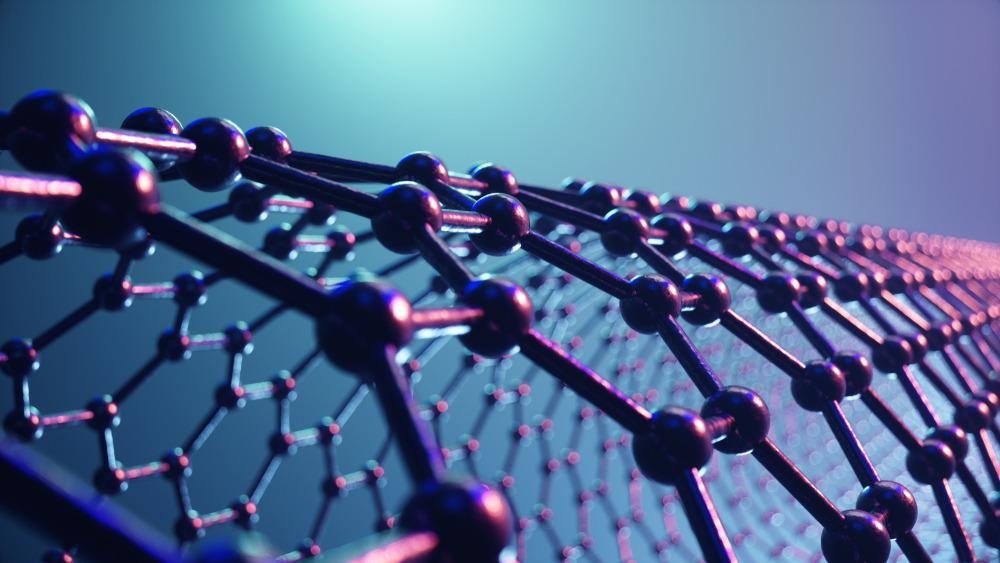Chinese researchers have published an article in the journal Carbon, in which they have focused on the photon anharmonicities existing in graphene materials employed during the implementation of nanotechnology-based electrical gadgets.

Study: Phonon anharmonicities in 7-armchair graphene nanoribbons. Image Credit: Rost9/Shutterstock.com
What is Phonon Anharmonicity?
Anharmonicity is described in classical physics as the regressive connection between any resonator and the generalized loads and movements.
Anharmonicity is more narrowly concerned with the effects that happen after the harmonic and quasi-harmonic limits have been reached.
The notion of phonons, or weakly interacting waves of atomic (or ionic) oscillations and related quasi-particles, underpins crystalline lattice movements.
A phonon is a subatomic particles description of a sort of vibrational motion in which a lattice pulsates at the same frequencies consistently. Thermal kinetics in minerals are governed by anharmonic lattice vibrations, which show how atoms react and generate heat
. Thorough knowledge of the nanoscale process of phonon anharmonicity in concentrated environments is required for the development of superior functional and efficient semiconductors.
Temperature Dependency of Phonons
Owing to phonon anharmonicity, thermal radiation, and platform consequences, phonons display either linear or nonlinear temperatures dependency in frequencies, which is an important component in understanding the temperature impact on the selection of electrical and optical equipment.
Raman thermometers, for example, are used to explore the heat capacity of certain materials based on the linear temperatures’ dependency of Raman mode. The temperature dependence of phonon scattering in various carbon-based nanostructures with important and fundamental electrical and heating characteristics, such as graphene nanoplates, carbon nanotubes (CNTs), and carbon nanotubes (CNTs), is now well understood (CNTs).
Information Regarding Graphene Nanoribbons (GNRs)
Graphene nanoribbons (GNRs) are a useful replacement to zero latency graphene and have been used in succeeding nanoelectronic devices such as FETs.
In most cases, phonon anharmonicities in biomaterials play an important role in system efficiency. Graphene nanoribbons (GNRs), one-dimensional thin strips of graphene with a thickness just under 10 nm and a substantial electrical energy band that can be controlled by the thickness and border morphologies, carry the potential of overcoming the direct bandgap diamond limitation.
More from AZoM: An Overview of Machine Learning Applied to High Entropy Alloys
Many different types of GNRs have been manufactured over the last decade using chemical ablation or on-surface processes and have been used in upcoming nanoelectronics devices such as FETs. On-surface produced nanomaterial armchair GNRs with widths about 1 nm have been extensively studied utilizing an in-situ scanning electron microscope in extremely low heat and extremely high-pressure circumstances.
Competent ex-situ characteristics of such AGNRs under environmental conditions are necessary for realistic use in nanotechnological electronic applications.
Analysis Techniques and Raman Spectroscopy
Raman spectroscopy is an ex-situ analytical method that may be used to noninvasively and swiftly determine the existence and characteristics of AGNR transmitted from metal substrates onto insulators, depending on the existence of the AGNR-width-dependent fingerprint radial breathing-like mode (RBLM).
Because AGNRs grown on substituent substrates such as Au(11 12 12) and Au(788) are strongly oriented along the stepping orientations, they display apparent anisotropic in both G and RBLM phases even when transferred to silicon platforms, which can be utilized to identify AGNR-covered regions from others. Raman spectroscopy might potentially be used to confirm that the changed organic molecules in AGNRs are still present.
Research Findings
The surface of Au (111) was nearly completely densely populated with 7-AGNRs longer than 30 nm. The prominent peak at 1595 cm-1 was attributed to the G model, which was a practical vibrational method for all graphene sheets with sp2 C-C bonds and resulted from in-plane C-C bond straining.
A D mode at 1350 cm-1 was seen in graphene with defects as a result of two dispersion processes: one scattering event caused by crystalline structure and one inelastic scattering event caused by emitting or absorbing an iTO phonon.
Similar to the study of dangling graphene and substrate stabilized graphene, it was discovered that 7-AGNRs withstand less pressure. The prominent herringbone-like reconstitution of Au (111) on the 7-AGNR sheets further demonstrates the poor adhesion contacts between 7-AGNRs and the Au (111) substrate.
Temperature profile Raman spectroscopy was used to explore the anharmonicities of G mode and RBLM of on-surface synthesized high-grade 7-AGNRs in the range of temperature of 80 to 520 K. While the G model of 7-AGNRs decreases ambient temperature, the RBLM of 7-AGNRs decreases logarithmically with heat. The line thicknesses of all phonons expand discontinuously with warming.
The nonlinear characteristics of RBLM are mostly caused by quartic-phonon decay processes.
To summarize, the anharmonicities were carefully studied in the graphene material and were compared with pre-existing data. These discoveries will benefit future applications of AGNRs in optical and electrical devices by offering insight into the thermal characteristics of 7-AGNRs.
Further Reading
X. Guo, Q. Tian, Y. Wang, J. Liu, G. Jia, W. Dou, F. Song, L. Zhang, Z. Qin, H. Huang, Phonon anharmonicities in 7-armchair graphene nanoribbons. 2022. Carbon. 190. 312-318. Available at: https://www.sciencedirect.com/science/article/pii/S0008622322000355?via%3Dihub
Disclaimer: The views expressed here are those of the author expressed in their private capacity and do not necessarily represent the views of AZoM.com Limited T/A AZoNetwork the owner and operator of this website. This disclaimer forms part of the Terms and conditions of use of this website.